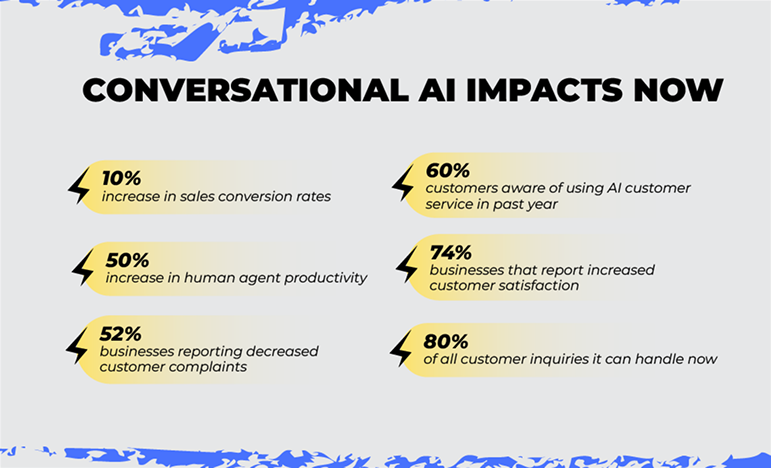Conversational AI has changed the game.
Because while people may say they don’t want to talk to a machine, their behaviour with AI says otherwise. Consider that: ChatGPT averages 123.5 million daily active users. They process over one billion queries a day, according to their most recent reports.
- ChatGPT averages 123.5 million daily active users.
- They process over one billion queries a day, according to their most recent reports.
- 87% of consumers say their chatbot interactions overall have been positive or neutral.
- And 62% say they prefer talking to AI if they’d have to wait for a person.
Pair that with multimodal capacities for audio and video, and it’s easy to see why AI automation has changed the way businesses handle calling. It’s not right to say a revolution is happening with AI in customer service in 2025, because the truth is: it’s already happened. In this article, we go back to the beginning, covering what AI-powered calling is, how it works, and how it’s redefined communication for businesses in 2025.
Reaping the Benefits of AI-Powered Calling
Reaping the Benefits of AI-Powered Calling “AI-powered automated calling” is a catch-all for conversational AI solutions to business telephonic communication problems, whether inbound or outbound. These platforms make or field calls entirely without your intervention, combining conversational AI with advanced data processing. They allow AI to share information, upsell and re-connect, gather customer insights, pre-screen candidates or potential clients, and even do administrative work like scheduling. They’ve already been deployed across businesses and departments to do the heavy-lifting, freeing the human beings to focus on things they’re really needed for. AI-powered calling is bringing companies greater: Efficiency: Exponential cost reductions and freeing up staff at the same time. Scalability: Making hundreds to thousands of calls simultaneously, with each one tracked and logged. Personalization: Tailoring calls with business data and making adjustments on the fly to improve mood and understanding. AI calling automation is already giving these benefits:

Conversational AI Technology: The Mind Behind the Call
Conversational AI Technology: The Mind Behind the Call Okay, fine, but what is conversational AI? Let’s look at how it works and why people find it so engaging. How It Works Conversational AI reduces language into tiny pieces that can be transformed, analyzed and processed by computers. And from here, it can also build it back up in the reverse. AI-calling relies on several things working together, like: Powerful Data Processing: It all begins with those massive datasets of human language. This is processed so queries and responses are understood with context, intent, and sentiment. That allows on-the-fly adjustments to emulate human communication. Natural Language Understanding (NLU): This is part of Natural Language Processing (NLP) and how AI parses speech. It identifies keywords, context, and even emotional undertones, to assist with interpretation. For example, if a customer says, “I need help with my bill,” the AI recognizes “help” as intent and “bill” as subject. Natural Language Generation (NLG): With meaning registered, the system is ready to make the response. Unlike old calling automation systems that needed pre-recorded messages, NLG makes customized dialog that fits business goals and the context of the conversation. Voice Synthesis: With the words you’re ready for voice, so here AI converts it to audio, giving it a natural-sounding tone and demeanor. Advanced systems go further, using neural voice synthesis, to mimic human inflection and tone even more effectively. Machine Learning Algorithms: This is all fine and well, but it’s not much good without improvement. What makes AI calling systems work is the capacity to adapt and keep adapting from each interaction. Machine learning refines accuracy and enables this learning to each new scenario. In other words: the more they’re used, the better they become. Here’s an example of a typical flow:
Conversational AI Benefits –
Conversational AI Benefits –

- Powerful Data Processing: It all begins with those massive datasets of human language. This is processed so queries and responses are understood with context, intent, and sentiment. That allows on-the-fly adjustments to emulate human communication.
- Natural Language Understanding (NLU): This is part of Natural Language Processing (NLP) and how AI parses speech. It identifies keywords, context, and even emotional undertones, to assist with interpretation. For example, if a customer says, “I need help with my bill,” the AI recognizes “help” as intent and “bill” as subject.
- Natural Language Generation (NLG): With meaning registered, the system is ready to make the response. Unlike old calling automation systems that needed pre-recorded messages, NLG makes customized dialog that fits business goals and the context of the conversation.
- Voice Synthesis: With the words you’re ready for voice, so here AI converts it to audio, giving it a natural-sounding tone and demeanor. Advanced systems go further, using neural voice synthesis, to mimic human inflection and tone even more effectively.
- Machine Learning Algorithms: This is all fine and well, but it’s not much good without improvement. What makes AI calling systems work is the capacity to adapt and keep adapting from each interaction. Machine learning refines accuracy and enables this learning to each new scenario. In other words: the more they’re used, the better they become.







